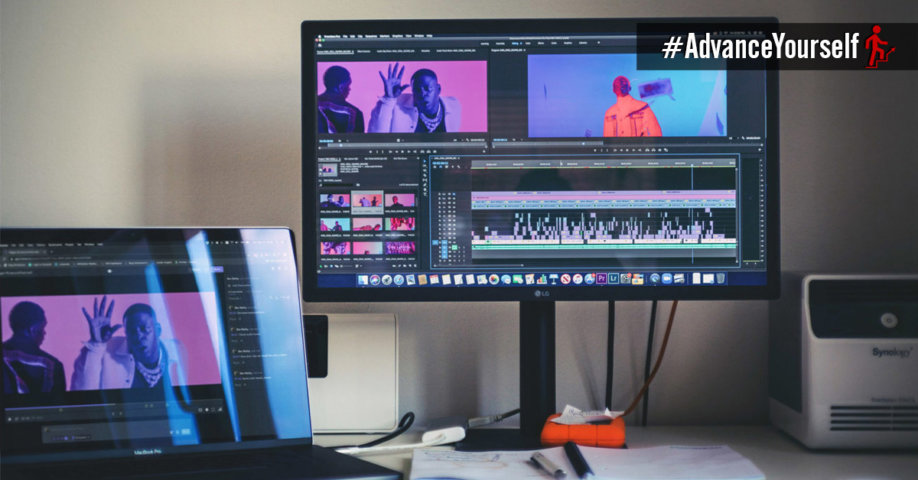Author’s Note: The following is an article I originally wrote with Lisa McNamara for the site Frame.io titled “Best Practices for Adopting a Remote Post-Production Workflow” republished in its entirety below.
» Click here to access the original article at Frame.io
There’s no question that remote workflows have rapidly become one of the hottest topics of 2020.
Companies of all sizes (and in nearly every industry) are looking for more sustainable, flexible, and scalable solutions for employees to work from home or, at least, outside of the traditional central office.
As many of us have learned, running an efficient post workflow from home can be tricky. As nice as it is to skip the commute, trading a quiet editing suite for your house brings many distractions and challenges, but if we want to stay in business, we have to maintain the same levels of efficiency and productivity our clients expect (and the market demands).
However, these changes may be signs of things to come. Just like with all the technological advances of the last century, the film and television industry is starting to leverage cloud-based tech. There are potentially massive cost benefits in remote workflows, and big players in the industry are taking note.
That’s why getting your remote workflow up and running now will keep you from getting left behind as your clients (and competitors) make the transition.
But don’t worry! Our remote futures don’t have to be scary, you just need to know where to start.
In today’s article, we’ll share best practices for managing an efficient remote post-production workflow. Whether you’re a team of one or one thousand, these principles should help you make informed decisions about transitioning to a remote workflow.
So ask yourself: are you ready?
If so, let’s dive in.
- Introduction
- Managing Media and Projects
- Managing Communication
- Managing Collaboration
- Managing Morale, Well-Being, and Sanity
First things
As a company that’s spent the last five years building cloud-based post-production tools, we at Frame.io are doing our best to provide assistance and information to professionals shifting to remote workflows.
For this article, we consulted editor and remote-workflow expert Zack Arnold, ACE.
With 15 years of experience, there are few in the industry with the same insight and knowledge on this subject as Zack. He’s a great resource on everything from boosting creativity to how to work with clients and collaborators. He also knows a thing or two about taking care of yourself while working from home.
The first step of setting up your workflow from home, according to Zack, is to examine your current configuration.
“With any sort of big change to your business, technical, or creative process, it’s important to know where you’re starting from,” he says.
“Once you’ve got a good mental map of your workflow, start thinking about the base requirements, and formulate some questions that will help you evaluate the possible solutions.”
Editors, assistant editors, colorists, or VFX artists should start by asking, “Will this tool or approach allow me the speed and quality my clients require?”
Producers or post-production supervisors will need to evaluate how remote collaboration might be possible given an existing infrastructure.
Production companies and studio executives might be most concerned with questions like, “Do our creative teams have the resources necessary to complete contracted projects? And if not, do we have the budget to expand our capabilities?”
Beyond that, everyone should ask, “Do I have the tools in place to ensure that working from home won’t drive me and my team absolutely insane?”
You should ask these questions repeatedly throughout this process, because the answers will help you choose the best solutions for your needs.
Setting the stage
The last decade has seen rapid advances in technology, especially in internet bandwidth and low-cost compute and storage resources. We’re finally at a point where working from home is a viable option, even on a freelancer’s budget.
That said, remote work is still far from the norm for many larger teams, high-budget productions, and the major studios—especially in television and motion pictures.
Why is this? Surely bigger budgets would mean easier adoption of the latest and greatest (and most comfortable) workflows.
While it’s true that larger teams have the resources to deploy remote workflows, there are several common objections that have slowed its adoption:
- The multitude of security concerns
- The burden of remotely managing and syncing large amounts of media
- Communication bottlenecks between remote team members
- The perceived challenges of remote creative collaboration
These are all reasonable considerations, but as we’ll see, they’re all addressable.
Counting the cost
Assuming you need to build a sustainable, long-term remote workflow (i.e., not the occasional editing session from a coffee shop), your first consideration is cost.
If you’re a “one-stop shop” (i.e. producing, editing, sound, color, etc.), any increased costs will fall on you. But remember, your time is valuable, so investments that make you more productive or efficient are good for business.
If you’re part of a relatively small team, things can be a bit murkier. Any moderate investment in remote workflow gear required by your employer will most likely be covered by them (Hint: this might be your chance to finally upgrade your high speed internet on someone else’s dime). And even though certain things will be negotiable, like storage drives and software licenses, the transition may be your best opportunity to invest in the tools you need to market yourself to any employer globally—without being dependent on someone else’s equipment.
If you’re part of a much larger team (or you manage that team), and you have to coordinate with tens, or even hundreds of employees remotely, large investments will need to be made far beyond the capabilities of individual employees. So the best you can do is to provide guidance and suggest possible solutions to those making the financial decisions.
At the end of the day, know that your remote workflow will have to meet the expectations for quality and timeliness that your clients expect. Pay accordingly.
One of the truisms of our industry is FAST, CHEAP, and GOOD—pick two. And it’s no different when you’re working remotely.
What about security?
Before diving into the numerous options for building a remote workflow, we have to address a key issue when it comes to high value content—security.
Studio and post-production executives are terrified about the (legitimate) security concerns, but we’re now at the point where we have to choose between the financial cost and the human cost.
So let’s assume that your organization’s security policies allow you and your team to work from home, and all protocols and systems are in place to protect your data and files—or that it’s worth the risk, given the alternatives.
For teams already leveraging Frame.io, you’re protected by enterprise-level security at every point in our platform.
But if you’re new to cloud-based workflows, make sure your assets and projects are stored on platforms with TPN and MPAA security certifications. Many incumbent cloud storage platforms do not hold these certifications, so be sure to double check before you sign up.
1. Managing media and projects
Post-production workflows live and die by their ability to efficiently and safely move assets through the pipeline. This is especially true of remote workflows.
Depending on your team’s scale, resources, and flexibility, there are two broad categories of remote workflow you can adopt: Pure cloud workflow or a Hybrid cloud workflow.
Pure cloud workflow
When it comes to the hardware required to move lots of assets around, pure cloud workflows can be very appealing.
Since all your assets and project files are stored in the cloud, you don’t have to manage your own hardware. That means the engineering and support required to operate large volumes of data is greatly reduced.
Whether you need 1TB or 1000TBs, pure cloud workflows enable you to scale up far faster and with much higher uptime than handling all the hardware yourself.
As far as media management software is concerned, Hedge’s Postlab and Kyno are fast-becoming the go-to solutions. Both handle all kinds of media while preserving metadata, and make drive transfers/file verification easy. They both integrate with Frame.io, so you can push everything to cloud storage with just a couple clicks.
If you already use another media management software, there are other options to make your assets accessible in the cloud.
We recommend Watch Folders to automatically sync files to the cloud from any desktop media management system. You can even automate this process with the right tools. There are many other cloud storage products with similar desktop apps, but they don’t cater to post-production workflows.
Once your files are up in the cloud, Frame.io’s Premiere Pro, FCP X, and DaVinci Resolve integrations let you pull assets right into your project/timeline. It’s an easy plug-and-play setup to get you rolling with a cloud-based workflow.
Zack recognizes there are lots of different options out there, but Frame.io is his go-to. “You can research and analyze all the different platforms and software ad nauseum, but if you’re looking for a simple, highly secure, flexible solution, you can get up and running pretty immediately with Frame.io.”
Hybrid cloud workflow
If your team is not yet ready for a fully cloud-based workflow, then the next best option is a hybrid cloud workflow.
In this type of workflow, you leverage both on-premises storage and compute hardware, while using the cloud for asset transfers and syncs between team members.
For the sake of brevity in this article we’ll intentionally avoid diving down the rabbit hole of “But which workstation is best? Which are the fastest drives?” etc. That’s what Google and Michael Kammes are for.
Assuming your team has significant on-premises media management/storage infrastructure already, you’ll need to find a way to share and sync those assets and projects. Your first and cheapest option is the “SneakerNet” workflow.
SneakerNet – With a SneakerNet Workflow, every team member keeps their own local storage drives that are all manually mirrored with the same media and file directories.
There are lots of software options to help you accurately mirror drives—just run a simple Google search for “drive mirroring software.” Zack’s tool of choice in this category is ChronoSync, which is an affordable and reliable option.
The “sneaker” part of this network is the PA or assistant who runs all over town constantly updating everyone’s media on their various drives and ensuring everything still relinks properly as directories are renamed and media is moved around. If you want to give your PA a break, you can set them up with tools that let you sync over the cloud, but it will still be a manual process.
Automatic media syncing – If you’re used to more traditional workflows, where all your assets are stored in a central facility, there are numerous automatic media syncing solutions that can work for you.
Of course, Kyno and Postlab let you automatically sync media between local drives, using Frame.io for transfers between team members. But if you want more options for direct duplications to local media, here are Zack’s recommendations.
“There are basically three tiers of this type of solution, which range from extremely affordable options to more robust solutions that cost a bit more,” Zack explains.
“On the bottom tier are the desktop clients for older cloud storage solutions like G Suite, Dropbox, and Onedrive (or iDrive, remember that?), but if you’re managing large amounts of data long term, these may break down. Don’t expect multiple team members to keep a properly organized asset library with these sorts of solutions,” Zack says.
It’s important to keep in mind that many of these platforms don’t have our industry’s recommended security certifications. So double check before you buy.
In the next tier, Zack recommends tools like Resilio Sync and ViceVersa “These tools do a better job of syncing media between multiple workstations directly, in a more controlled way than the first tier. That said, they don’t offer the same flexibility for automatic cloud backups. But, they do a much better job of matching your data between locations, and keeping it mirrored appropriately,” Zack explains.
“At the higher end of the media sync tier you have options like DNAFabric. This tool doesn’t just sync your media, it also understands metadata (e.g. Adobe AAF files, Avid bins, etc.), so it can also assist you when it comes time to conform or online.”
Virtualized workflow
Another option for incorporating the cloud into your processes is a virtualized workflow.
This type of workflow is usually cloud-based, but intentionally mimics traditional brick-and-mortar facility. Here are Zack’s top recommendations for syncing media and keeping remote teams connected in a way that’s no different from having a central SAN down the hall.
Remote desktop – Remote desktop tools transform your home computer into a terminal, so to speak, for the workstation at your office.
In a sense, remote desktop tools are the “hybrid cloud” variant of a virtualized workflow, but it depends on your exact setup.
The usual suspects in this space are services such as Team Viewer, Apple or Microsoft Remote Desktop, GoToMyPC, etc., all of which allow your main office workstations and media to remain intact, while you control your office workstation from home.
While this is a great solution, especially for tech support teams who can avoid driving across town just to fix a couple of glitches, it’s far from ideal for creative professionals who need a low latency interface that responds in practically real time.
If you want your project and timeline to feel buttery smooth and can’t stand reduced frame rates, out-of-sync audio, or overly compressed video, you’ll want to test vigorously to make sure it meets your usability standards.
Are remote desktop tools better than nothing in a pinch? Absolutely. Are they ideal for intense creative work? Far from it.
BeBop Technology – BeBop is essentially the first viable workstation-in-the cloud solution for post-production.
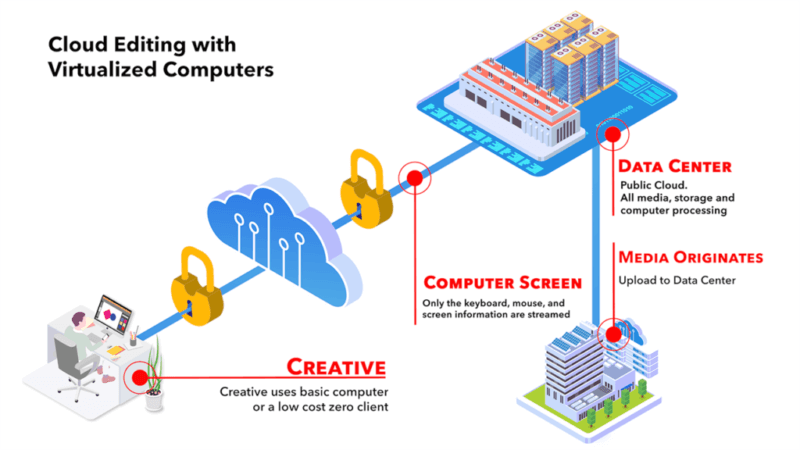
Image © Bebop Technology
BeBop’s pure cloud approach gives you instant access to your preferred post-production software in the cloud, transforming your local computer into a powerful virtual workstation.
With nothing more than a laptop and a reasonable internet connection, you can start cutting as if you’re in a fully equipped edit suite. But unlike an edit suite, you only pay for BeBop when you need it.
2. Managing communication
If you’re used to working in a collaborative team environment where everyone shares the same physical space, managing communication remotely may seem like a big hurdle.
Where you could once pop down the hall or be a knock away from checking in on a cut, chatting with your assistant, or strategizing with your other team members, you’ll need a way to streamline communication without it sucking up the many hours in your day that you need to be creative.
In Zack’s words, “If you take away one thing from this entire article, let it be this: Do not rely on email to communicate with your team.”
Email is the single greatest time suck to creativity. And it is the worst possible way to track notes and changes. In fact, if you didn’t already know, it’s the reason we created Frame.io in the first place.
Teams of all sizes
Slack – When you’re talking about internal team communications (schedules, logistics, etc.) Slack is far superior to email (and it’s free).

Image © Slack
According to Zack, “The very first task on my to-do list on day one of a new project is creating a Slack team and begging everyone else to use Slack instead of email. I find that the volume of email I get from team members is reduced by 80-90 percent, even when not everyone adopts this solution.”
And since Slack integrates with Frame.io, you can consolidate all your notes, conversations, and feedback in one place and prevent the endless email chains we all dread.
Project management
Similar to Slack for communication, your project management should be a centralized digital platform that works for your team locally and remotely.
There are a multitude of options, two of the more common being Airtable and Asana. But for anyone who’s familiar with Zack’s work, it’s probably no surprise that his number one recommendation for project management in post is Trello.
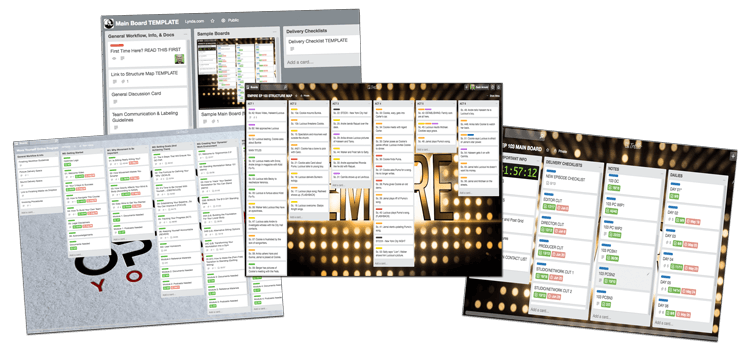
Trello is essentially a digital whiteboard with infinite customization that can be shared across all of your teams, and is accessible from any device. You can use it for tracking cuts and deliverables, individual VFX shots, documents, client notes, workflow checklists, etc. If you can pin it to a white board, you can organize it in Trello.
“Trello saves me hours by keeping all of my cut notes organized in checklists instead of never-ending email threads or random Word docs cluttering up my desktop,” Zack says.
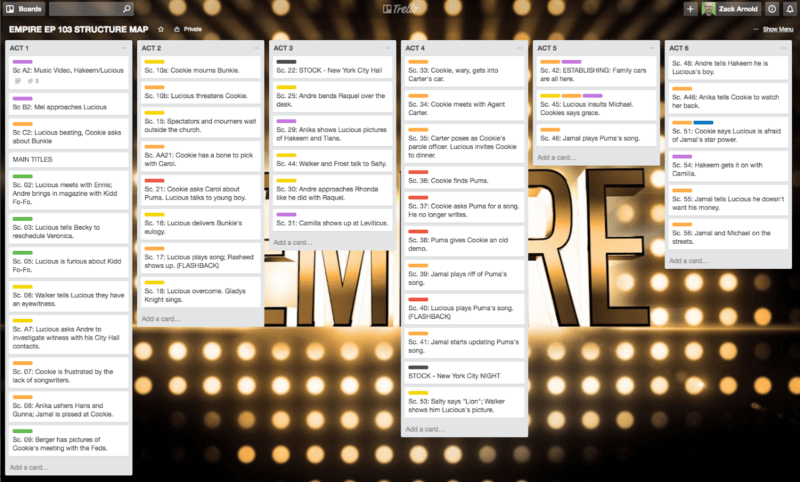
A Trello ‘Structure Map’ from an episode of Empire (season 1).
“More importantly, from a creative perspective, Trello is absolutely invaluable when it comes to visually organizing your shots, scenes, acts, and reels. For decades, many editors have employed the Walter Murch method of breaking down a show into index cards. And I have yet to find a project management tool for building a post-production workflow as solid as Trello.”
Note: Frame.io also integrates with Trello, and many of the most popular project management apps, so it’s easy to customize these tools for your existing workflow.
3. Managing collaboration
Once you feel good about syncing your media, your data, and your project files, and your team can communicate effectively (without relying on email), your next challenge will be the collaborative process outside your internal team.
As post-production professionals, we don’t live in a vacuum. Unless you’re writing, producing, shooting, editing, finishing, and delivering your own work, you need to collaborate with external clients or stakeholders. And often, many of them are not tech-savvy enough to use (or keep organized) the more sophisticated tools.
That’s why Zack recommends Frame.io for client collaboration. “Whether you’re tracking single cuts, or hundreds of individual VFX shots, Frame.io is the best all-in-one tool for organizing creative feedback and keeping clients and collaborators on the same page. The interface is simple-to-use, intuitive, and beautiful. I genuinely believe this tool is the future of remote video collaboration in the cloud-based age,” Zack says.
“To be honest, I would recommend employing these collaboration methods even if you don’t have a remote team. Your clients will thank you profusely, because they’re so much faster and easier than anything we’ve ever had in this industry.”
Managing teams of all sizes
Frame.io – Let’s take a deeper look into how Frame.io fits into your cloud-based workflow.
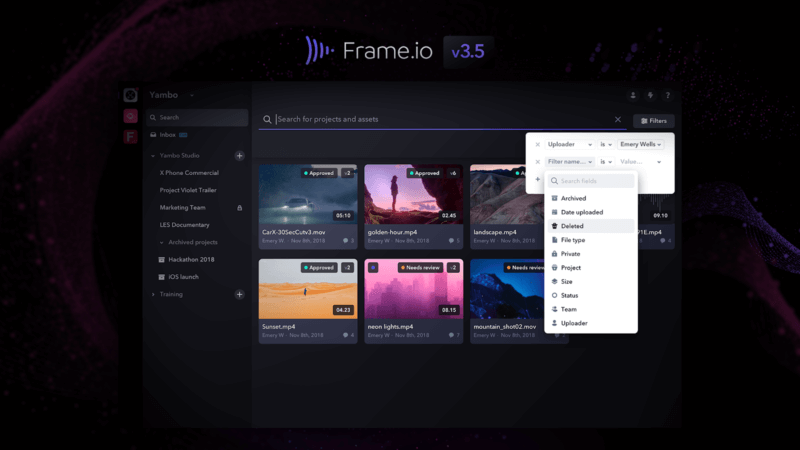
Because our platform handles nearly every post-production file format, automatically generates proxies, and integrates with all of the major NLEs, it’s very quick to get up and running in your existing workflow.
It also unlocks new efficiencies for your team. Our unmatched upload speeds make it easy to deliver original, full-resolution file assets to vendors from VFX shops to conform and color facilities. That means they can work their magic faster and then deliver finals right back to you in the same place.
“I’ve used it on many projects, and know that many high-end productions use it on everything from major motion pictures to broadcast television to commercials,” Zack says.
Plus, our award-winning iOS app for iPhone and iPad helps teams communicate from anywhere. These apps are also helping bridge the gap between production and post-production, by letting teams review takes right on set, and delivering dailies in minutes.
For large organizations, our security scales to your workflow, and meets standards for Hollywood’s highest-value content.
“In short, I believe it’s the way all teams should (and will) collaborate, whether local or remote,” Zack says.
Zoom – If you need to coordinate a conference call for 5-25 different people across town or cross-country, Zoom should be your first choice.

Image © Zoom
“Whether you need to get live feedback on VFX or narrative cuts, Zoom helps you get everyone in the room who needs to be there, no matter where they are,” Zack says.
Zoom’s synchronous collaboration toolset and video quality are robust, not to mention surprisingly affordable.
Streambox – Streambox provides post-professionals real-time remote collaboration for the more pixel-perfect tasks like color grading, VFX editing, or monitoring audio in 5.1 surround, for example.
The major difference with Streambox is that it’s hardware-based rather than browser-based and it doesn’t include the collaboration tools (video conferencing, recording, screen sharing) that some other solutions do.
But it does give you the ability to output your full quality signal to any facility in the world—and it’s encrypted. Just know that Streambox requires a fair amount of time and money to implement.
4. Managing morale, well-being, and sanity
Aside from the many technological necessities that will allow you or your team to collaborate remotely, the most neglected part of your new workflow is most likely going to be the human one.
Yes, you might have a seamless end-to-end media management solution, an organized communication workflow that virtually eliminates the need for email threads, and the collaboration tools to make your clients feel like they’re sitting next to you on the couch.
But if you’re suddenly asked to work at home, do you have a workflow to manage the dog that needs to be walked every 90 minutes? Or the baby that needs diaper changes? Or the kids banging on your door every five minutes because the wi-fi went out again and they’re missing their favorite Netflix shows?
If you are in the position of managing your team, do you have protocols in place to ensure the transition from local to remote work doesn’t cause a drastic shift in team morale? Or are there strategies you can offer to ensure that your team members can maintain the same levels of focus and creativity?
“I don’t care how much you invest in technical workflow solutions—if you don’t also manage the newly found interruptions and distractions that constantly arise from working at home, your remote workflow and your team’s productivity and overall effectiveness are Dead. On. Arrival,” Zack states.
That’s why he created his Optimize Yourself program as a solution for improving work-life balance, and for building better productivity and creative muscles.
Move Yourself
The biggest struggle Zack observes in coaching clients who have to work from home is how much less they move throughout their workday. You might think you’re sedentary at the office now, but it gets worse from home.
You no longer have the excuse of parking as far away as possible to get in more steps before the day begins, taking the stairs instead of the elevator, walking down the hall to chit-chat with coworkers, walking to lunch a couple of blocks away, or just moving from office to office to get your questions answered. At home, you’ll be virtually stuck in front of your workstation in perpetuity if you don’t build the regular habit of movement.
“If you’re the individual working from home, start by setting an alarm in the afternoon so, at a minimum, you step away from your computer for 15 minutes to get some fresh air, sunlight, and to collect your creative thoughts for the afternoon push,” Zack says.
“I also recommend increasing your daily intake of water to force you to step away more often for bathroom breaks,” he recommends. “And I suggest working in “time blocks” so you don’t burn yourself out over the course of the day. Build in 5 to 10-minute activity breaks at the end of your time blocks to keep the blood flowing to your brain.”
If you’re managing a team, perhaps you can sync everyone via Apple Watches, Fitbits, or similar fitness tracking wearables to encourage friendly competition that encourages more physical movement, and thus more creative energy and morale.
This is such a complex topic that he wrote The Ultimate Guide to Building a Healthy Workstation (and Being Less Sedentary). It includes suggestions for adjustable standing desks, essential tools for both sitting and standing (as well as to reduce chronic pain), and ways to modify your daily habits to make increasing your movement practically effortless.
Focus yourself
Aside from prioritizing additional movement into your otherwise sedentary workday from home, your next priority is managing the many interruptions and distractions that will steal your (or your team’s) focus and creativity.
The first step is having an honest discussion with everyone in your household about the value of not being interrupted. And once they understand why longer stretches of ‘Deep Work’ are as vital to your job as the tools you use, the second step is creating a signal so people understand when you can or cannot be interrupted.

Zack calls this the “Tie On the Door Technique.” “We all remember what the tie on the doorknob meant back in college,” he says.“Now it’s time to apply that same theory to your focus and creativity.”
With interruptions (mostly) managed, your second step is managing the much more detrimental distractions in your (or your team’s) work environment.
Wait…what’s the difference?
Interruptions are outside your control. Distractions are very much within your control, and without your even realizing it, you most likely seek distraction throughout your workday.
We’re talking about Facebook, Instagram, email chimes, text message dings, news feeds, and all the noise and chatter that can add up to hours a day of lost productivity and creativity.
“If you find yourself getting sucked down the rabbit hole,” Zack says, “ my first suggestion is the Freedom app. It will help you block all of the various sites and apps that seek to steal your attention. Once you’ve minimized as many distractions as possible with Freedom, the next step is putting your phone in Airplane mode during your time blocks and hiding it out of your field of view. This one change alone can transform your entire workday.”
If you’re in the position where you have to manage communication across multiple remote team members and you’re afraid of not being able to get in touch with someone at a moment’s notice, Zack recommends instituting a rule where they are available via one single line of open communication (preferably not via phone). Again, Slack works well for that.
Connect yourself and your team
One of the most common challenges that many remote workers have is the feeling of isolation that comes from spending the majority of their time with no human contact.
If you’re used to interacting with co-workers all day long and you’re suddenly forced to work from home for an extended period, and if you don’t recognize and manage your need for interaction, it’s easy to slip into depression without even realizing it. As someone leading a team, it’s also imperative to manage the mental health and well-being of your team so the remote workflow you’ve built doesn’t become a giant morale-sucking black hole in a hurry.
Zack recommends staying in contact with friends and colleagues via text, Slack, or in Facebook groups. And beyond that, doing your best to get out of the house at least once a week for an activity with friends in person (assuming current circumstances allow it). A walk, hike, or social activity can do a lot to boost your mental health.
If you’re in charge of managing your team, make it a point to set up in-person meetings (if possible) on a regular basis to reconnect your team members, whether it’s a screening, a lunch, or even a Friday afternoon walk that doubles as a “weekly summary” meeting.
Your mental health and the mental health of your team are the cornerstones of your creativity and productivity. Don’t take them for granted.
Lastly, here are Zack’s 10 additional strategies to maintain work-life balance when working remotely.
The Time Is Now
Whether we like it or not, the time has come to take remote workflows seriously on a global scale.
Yes, there are financial and logistical challenges to making it work, but there are also tremendous benefits for everyone involved.
The frontline artists and creatives can spend more time at home (and less time in the car). Directors and producers will gain new tools to collaborate remotely from sets across the world. And executives will find more ways to save money, while retaining (or enabling) access to a global pool of talent.
At Frame.io, we’re not just here to help you navigate through the short term challenges. Our goal—five years ago, today, and well into the future—is to remove all the barriers in your workflow, so you and your team can be more creative and efficient. No matter the circumstances.

